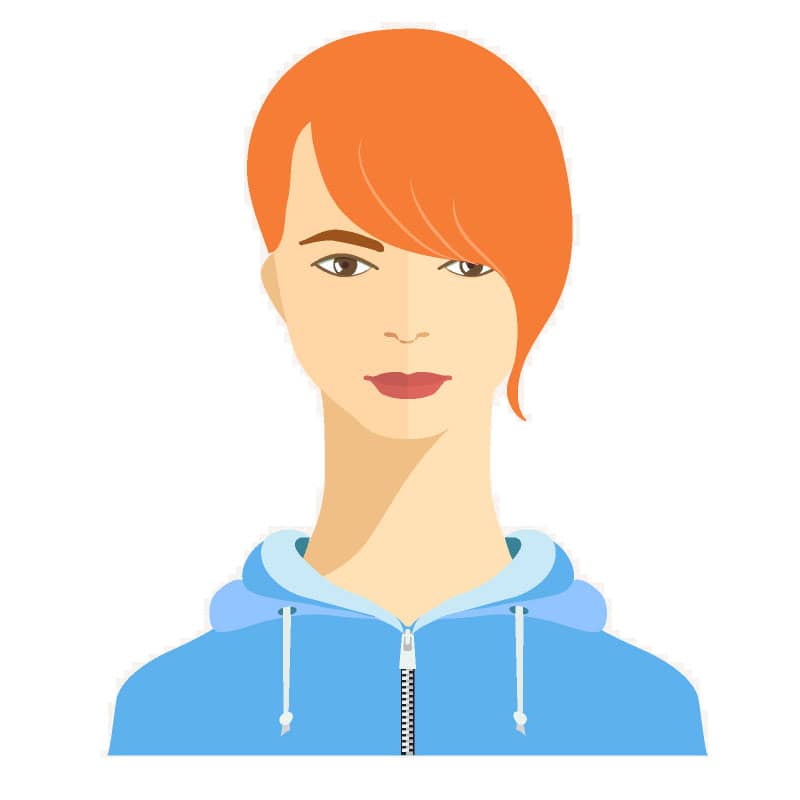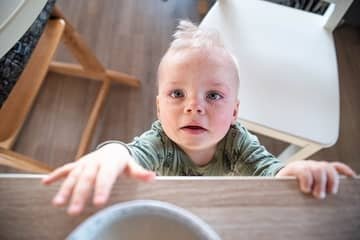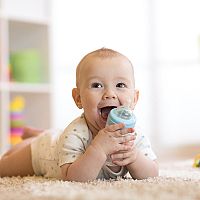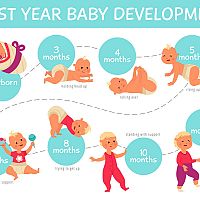
7-month-old baby (child) - development, diet, sleep, exercises, toys. See what it can do
Progress in the baby's movements is characteristic for the 7th month. Of course, each child develops at its own pace, but at 28 weeks, the child already manages certain prescriptive movements. The child is more socially active, the first teeth are usually already visible and the child also responds to calling his name. He is starting to syllabify more, and physical education from climbing or sitting is starting to become an obligation. Some of the more skilled ones can already reach four, although it is more of a stationary position and forward movement is not yet automated. However, crawling is completely normal. The central nervous system continues to develop and the growth spurt continues.
Some children are already able to sit up by themselves at least for a short while in the 7th month. This is a sign that the back muscles are developing well. However, they still cannot sit for long and it is not even completely healthy. Fine motor skills also develop, the child begins to work with his fingers, and instead of groping, his grip is smoother. Speech development shows progress and the repertoire of games expands. The child reacts to familiar faces, maintains eye contact, can react to grimaces and facial expressions. Breast milk is still on the menu, and the first solid foods should be introduced from the 6th month, while the child should have already tried several foods. Some children's sleep pattern stabilizes, but they often wake up at night due to hunger or teething. Do not forget to check with a pediatrician to assess the child's psychomotor development in the 7th month.
What can a 7-month-old baby do?
What should a 7-month-old baby know? Again, psychomotor development has an individual course for each baby. Therefore, regular visits to the pediatrician are important in order to observe any deviations. It is not correct to compare the individual development of your child with another, only a doctor can assess this. A small infant's locomotor system wakes up significantly. It is no longer just about individual movements of the limbs, but about the coordinated movement of all parts of the body. Rolling over from the stomach to the back and back is common and unproblematic for most children. Holding the head is stable, the child's spine is strengthened and the child can sit in a dining chair or in a folded car seat. However, still avoid "training" sitting, do not lean the child on a pillow in the crib or on the couch. Avoid the sitting position until the child is sitting alone. In the beginning, the child will rest his palms on the ground when sitting, which is fine and is a good signal.
Many children are able to get into the position on all fours, but they are not yet able to completely direct the movement forward, thanks to the exceptions. Therefore, crawling is still the most active movement. It is about preparing for climbing. If the child pulls himself up into a standing position, he cannot maintain his balance without support, but his knees bend less. Many can stand by leaning against a playpen or a couch. If the child learns to crawl (around the beginning of the 8th month), it is only a few steps away from trying to stand up and walk regularly. Of course, you still have to wait for that and you don't need to have exaggerated expectations.
The motor skills of the hands have also developed, and in the 7th month, children no longer use their hands as rakes, they can grasp even smaller things and transfer objects from hand to hand. At the same time, they can hold one object in their hand and grasp another with their other hand. They make symmetrical movements with their hands, for example, they rattle or bang toys. Train fine motor skills by putting toys - objects in the child's hands or placing them near him so that he tends to reach for them. The child is already practicing the "tweezer" grip - he does not use all five fingers, but the index finger with the thumb. Such grip often appears even in later months and is not a rule. Children already observe moving objects without problems, see colors and their vision is sharp. Compared to mature vision, their vision is still slightly myopic.
The first signs of whether the baby will be right- or left-handed may appear. The child already reaches for objects normally, and if you pay close attention, you will find out which hand he prefers when grasping toys or when pointing. However, the right or left preference is definitively decided around the 2nd year of life.
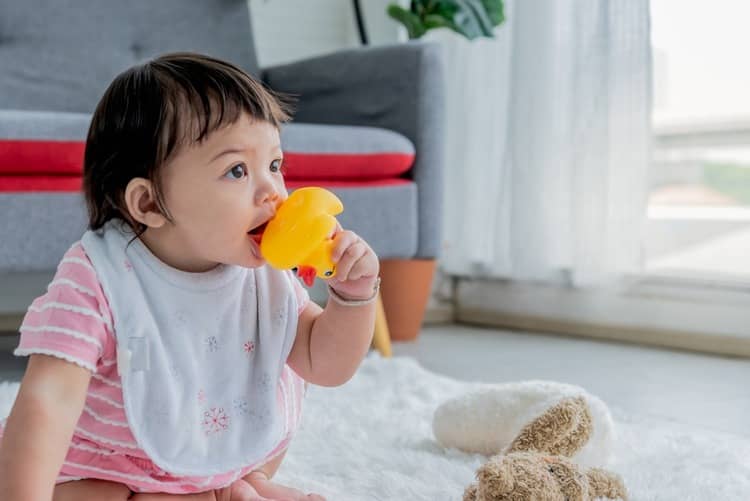
Even if some children can sit up by themselves at 7 months, it is not advisable to make them sit regularly at the beginning. Feel free to sit them in the chair during play or when feeding, but avoid regular sitting and wait until the child sits on his own without leaning forward and leaning on his palm. This movement does not need to be rushed in order to avoid damage to the spine. Later, such early unnatural sitting can be manifested by poor posture or weakened back muscles.
Speech skills and socialization of the child at 7 months
Already from the 5th month, the child is usually very active in communication. He is interested in his surroundings and tries to explore everything around him. A 7-month-old child is already making himself known clearly. He doesn't need as much sleep during the day, so it's important to pay attention to him and stimulate his sensory perception. He can react to a person's facial expressions, his smile or frown, he perceives his name. During socialization, he mainly prefers his mother or father. Separation anxiety and emotional attachment keep getting stronger. She is ashamed or afraid of strangers, so even visits to the doctor or visits to your home can be accompanied by crying.
He feels best in a home environment. There is progress in the development of speech, and meaningless babbling is replaced by repetition of syllables, ma-ma-ma, be-be-be, tu-tu-tu, ta-ta-ta. Actively communicate with the baby, he will smile and laugh loudly in return. The child also reacts by making loud noises or "yawning". While lying on his back, the child actively grabs his legs and joins his hands. The child is an observer, but at the same time he wants to do things by himself, by moving or pointing he tries to point out that something is interesting to him. The child begins to be aware of spatial presence. If you hide the toy under the blanket, the child knows that the toy is there. Hide and seek games are definitely on the agenda.
What can a 7-month-old baby eat?
Already in the 7th month, in addition to breast milk or artificial milk formula, the baby also receives solid food in the form of fruit or vegetable purees, purees, and can also handle chicken, turkey or rabbit meat without any problems. The menu is significantly expanding, so if a 7-month-old child does not want to eat, you have a wider selection of ingredients to choose from. Various recipes for rice porridge with fruit, corn or oat porridge are suitable. It is still true that children's first foods should not be sweetened or salted. Not even when it comes to soups or nutrition. Introduce gluten in the form of pasta, pastry or bread in small quantities, it puts a lot of strain on the digestive system.
If the child refuses any type of complementary food, always have in reserve the food that you know the child will eat. At first, mix the ingredients gently, later with the first teeth you can also try to break them with a fork. It is also suitable to prepare recipes for side dishes with steam, which preserves the maximum nutritional value and vitamins. Also secure bibs.

7-month-old baby - sleep and toys
7-month-old baby does not want to sleep? Even if a month ago your little one slept through the night, in the 7th-8th month the baby may wake up more often with a feeling of hunger, or it may be the growing teeth that complicate sleep. However, some children do not have any teeth even at this age and the growth will start later. Sleep regression can continue to disrupt falling asleep, the child is constantly developing, the growth spurt continues, and with these factors often comes unreasonable dissatisfaction and increased crying. The child wakes up from sleep just to change the position. It is therefore necessary to expect that 2 or 3 sleeps during the day will be accompanied by 2 or 3 awakenings during the night. Night breastfeeding is the ideal choice to soothe the little one.
The emotional bond between the child and the parents deepens. The child no longer lies motionless in the crib and wants to interact, communicates, draws attention to himself. Give him plenty of stimuli in the form of toys, sing songs, say nursery rhymes, watch books, imitate sounds. In addition to "Tap-Tap-Tapushky", play hide-and-seek (cover your face or hide a favorite toy under a blanket and take it out after a while) or " Aaran, baran buc ". You can really entertain the child with a lot of games. Beware of toys that could be swallowed when put in the mouth. Also, get toys that make sounds and are visually interesting. You entertain the child by talking, making various grimaces or gestures.

The most frequent questions - FAQ
The child is a month older again and gradually begins to realize his abilities. He records the most significant progress in movement. Rolling the baby from the back to the stomach and vice versa, crawling, pulling or even trying to climb on all fours are already on the agenda. Sitting is not yet a matter of course, but a short sitting and posture is no longer impossible. Non-dairy food enriches the diet and the 7-month-old baby actively perceives the surroundings, including parents and other people in the household. What advances in a 7-month-old baby surprised you? Join the discussion and share your experiences.
What to do if a 7-month-old baby is not talking?
How much water should a 7-month-old child drink?
How much food should a 7-month-old baby eat?
What is the weight of a 7-month-old baby?
Gallery
Pridať komentár
